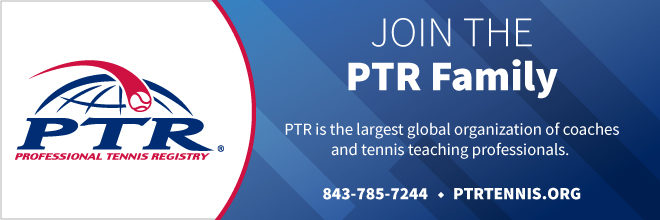|
 |
NOVEMBER
2019
A
CONVERSATION WITH
TGA PREMIER SPORTS CEO
JOSHUA JACOBS
|
abc |

 |
A Conversation with
TGA Premier Tennis CEO
Joshua Jacobs
TGA Premier Sports
has a great deal of success bringing golf and tennis into schools
and growing participation with your innovative curriculum and
pathway programs. In how many schools and facilities does TGA
Premier Tennis operate?
TGA operates tennis programs at 2,200 schools, community centers
and facilities. Our delivery system starts by bringing introductory
tennis programs that combine athletics and academics to schools
and community centers thus breaking down the barriers to entry
in the sport. After instilling a passion into the sport's newest
participants, we bridge the gap between off-court and on-court
and extend the player pathway by providing recreational programming
for youth and the entire family at facilities and local courts.
Since adding
tennis to TGA Premier Sports' youth sports offerings, you've
engaged more than 150,000 kids. If you stay on your intended
trajectory, what kind of growth and impact on the tennis business
do you foresee in the next five to 10 years?
Based on all of the positive feedback we are receiving from schools
and parents on our tennis programs, we have made a concerted
effort to focus on growth and expansion through a major infrastructure
change that will add 15-20 tennis chapters each year for the
next 3-4 years. Based on our average participants per chapter
and current growth trajectory of franchises, we plan to reach
1,000,000 tennis participants by 2025.

What are the
greatest benefits a child will gain from learning to play tennis?
TGA believes Sports Change Lives and the benefits of tennis in
this day and age are endless. Youth and families are active in
a sport that doesn't take a long time to play, costs are low,
hand-eye coordination and motor skills are developed, it's a
lifelong sport and studies have shown that youth who play tennis
have better academics and attendance in school. A win all around
and the earlier you start, the better.
TGA Sports
Foundation is enabling kids who wouldn't otherwise take up the
sport to learn and grow from it. What's the mission of the foundation
and how is it having a positive impact on youth across the country?
Our mission has always been too intertwine sport, education and
life lessons to change children's lives. The difference between
the TGA Sports Foundation and other youth sports foundations
is two-fold. First, we execute the programs and, second, we impact
the development of a child's sports career throughout all levels
of the player pathway. Introducing kids to sports and creating
a passion is one thing, but engaging a child who exhibits talents
and giving them the tools to grow and continue on with a sport
like tennis can make a lifetime's worth of impact on them. |
 |

 |
TGA Premier Tennis
classes aren't all serves and volleys. Your coaches incorporate
STEM/STEAM education components and life skills into the program.
Why is this important and what's the overall benefit to this
unique approach? How is it impacting kids and families?
TGA was the first program in the tennis industry to incorporate
STEM/STEAM, mainly because we had to break down barriers to entry
in bringing tennis into schools. Doing so made our programs be
truly viewed as enrichment and an extension of the classroom.
Adding this component also differentiated TGA's sports programs
from others in the marketplace making tennis programs more attractive
to parents and students who are deciding on which sport to try
or stay in. It gets tennis into places where it's not and puts
tennis on a level playing field with traditional sports in regards
to attracting new participants.
Tennis has
been tabbed as one of the sports, like golf, that is the most-played
by adults but the least-played by school-aged kids. With participation
shrinking among baby-boomers, what is TGA's approach to helping
reduce that generation gap, bringing more youth and millennials
to tennis?
When you look at the industry's numbers the past decade, tennis
ball sales are in line, which would equate to participation being
steady. What's masking the participation decline is that tennis
players are getting older and playing more but it's the same
people playing and they are aging out. There aren't many new
players coming into the game in America and that's backed up
by junior and adult racquet sales being off by over 40%. TGA's
approach is reverse customer acquisition for people ages 25-45.
Normally you go directly to adults, but TGA's approach is to
go where tennis isn't available for juniors, create the access,
and activate the juniors first in a safe environment while opening
a communication portal to the parents to engage them. |
 |

 |
Another unique
aspect of TGA is that it is the only youth sports business company
offering entrepreneurs the opportunity to own equity in a tennis
franchise. Your regional chapters are operated by a franchise
owner who has a connection to the local community. What are some
of the benefits of using this model?
In the past, tennis has relied heavily on volunteers and marketing
campaigns to grow the sport. TGA's model identifies local entrepreneurs
whose livelihood is based on activating new tennis participants
and retaining tennis players through unique programs that break
down barriers to entry into the sport. TGA chapter directors
engage new coaches, deliver programs and are vested in the sport's
success because their ROI is tied to them. A franchise model
also allows for a higher probability of consistent programs through
quality control measures which equates to increased retention
through the tennis player pathway while engaging a multitude
of generations.
As the developer
of this business that's impacted so many kids, families, communities
and entrepreneurs, what is most gratifying about your role as
TGA works towards enrolling its one millionth student?
I grew up playing tennis and want to see it thrive. TGA is one
cog in the wheel that makes up scores of tennis programs and
delivery systems that embodies tennis participation throughout
the industry. There's a pride among our organization that we
are, in some communities, the first exposure to tennis for youth
and adults. We get to set the table for the sport and the experience
students and parents will have throughout their tennis career
whether that be recreational or competitive. |
 |
|





